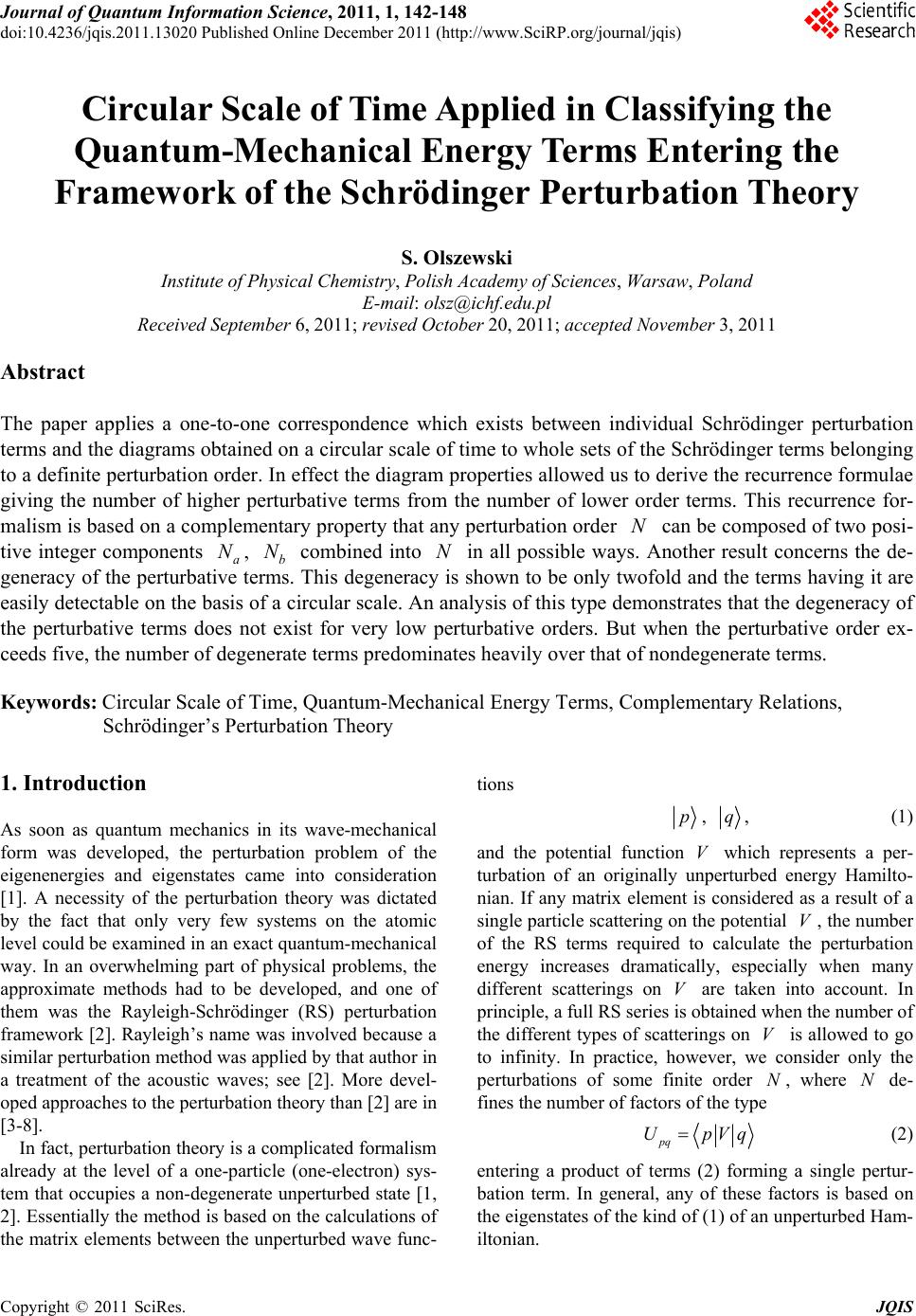 Journal of Quantum Informatio n Science, 2011, 1, 142-148 doi:10.4236/jqis.2011.13020 Published Online December 2011 (http://www.SciRP.org/journal/jqis) Copyright © 2011 SciRes. JQIS Circular Scale of Time Applied in Classifying the Quantum-Mechanical Energy Terms Entering the Framework of the Schrödinger Perturbation Theory S. Olszewski Institute of Physical Chemistry, Polish Academy of Sciences, Warsaw, Poland E-mail: olsz@ichf.edu.pl Received September 6, 2011; revised Octobe r 20, 2011; accepted November 3, 2011 Abstract The paper applies a one-to-one correspondence which exists between individual Schrödinger perturbation terms and the diagrams obtained on a circular scale of time to whole sets of the Schrödinger terms belonging to a definite perturbation order. In effect the diagram properties allowed us to derive the recurrence formulae giving the number of higher perturbative terms from the number of lower order terms. This recurrence for- malism is based on a complementary property that any perturbation order can be composed of two posi- tive integer components a , b combined into in all possible ways. Another result concerns the de- generacy of the perturbative terms. This degeneracy is shown to be only twofold and the terms having it are easily detectable on the basis of a circular scale. An analysis of this type demonstrates that the degeneracy of the perturbative terms does not exist for very low perturbative orders. But when the perturbative order ex- ceeds five, the number of degenerate terms predominates heavily over that of nondegenerate terms. Keywords: Circular Scale of Time, Quantum-Mechanical Energy Terms, Complementary Relations, Schrödinger’s Perturbation Theory 1. Introduction As soon as quantum mechanics in its wave-mechanical form was developed, the perturbation problem of the eigenenergies and eigenstates came into consideration [1]. A necessity of the perturbation theory was dictated by the fact that only very few systems on the atomic level could be examined in an exact quantum-mechanical way. In an overwhelming part of physical problems, the approximate methods had to be developed, and one of them was the Rayleigh-Schrödinger (RS) perturbation framework [2]. Rayleigh’s name was involved because a similar perturbation method was applied by that author in a treatment of the acoustic waves; see [2]. More devel- oped approaches to the perturbation theory than [2] are in [3-8]. In fact, perturbation theory is a complicated formalism already at the level of a one-particle (one-electron) sys- tem that occupies a non-degenerate unperturbed state [1, 2]. Essentially the method is based on the calculations of the matrix elements between the unperturbed wave func- tions p, q, (1) and the potential function V which represents a per- turbation of an originally unperturbed energy Hamilto- nian. If any matrix element is considered as a result of a single particle scattering on the potential , the number of the RS terms required to calculate the perturbation energy increases dramatically, especially when many different scatterings on V are taken into account. In principle, a full RS series is obtained when the number of the different types of scatterings on is allowed to go to infinity. In practice, however, we consider only the perturbations of some finite order , where de- fines the number of factors of the type V V N N pq UpVq (2) entering a product of terms (2) forming a single pertur- bation term. In general, any of these factors is based on the eigenstates of the kind of (1) of an unperturbed Ham- iltonian. 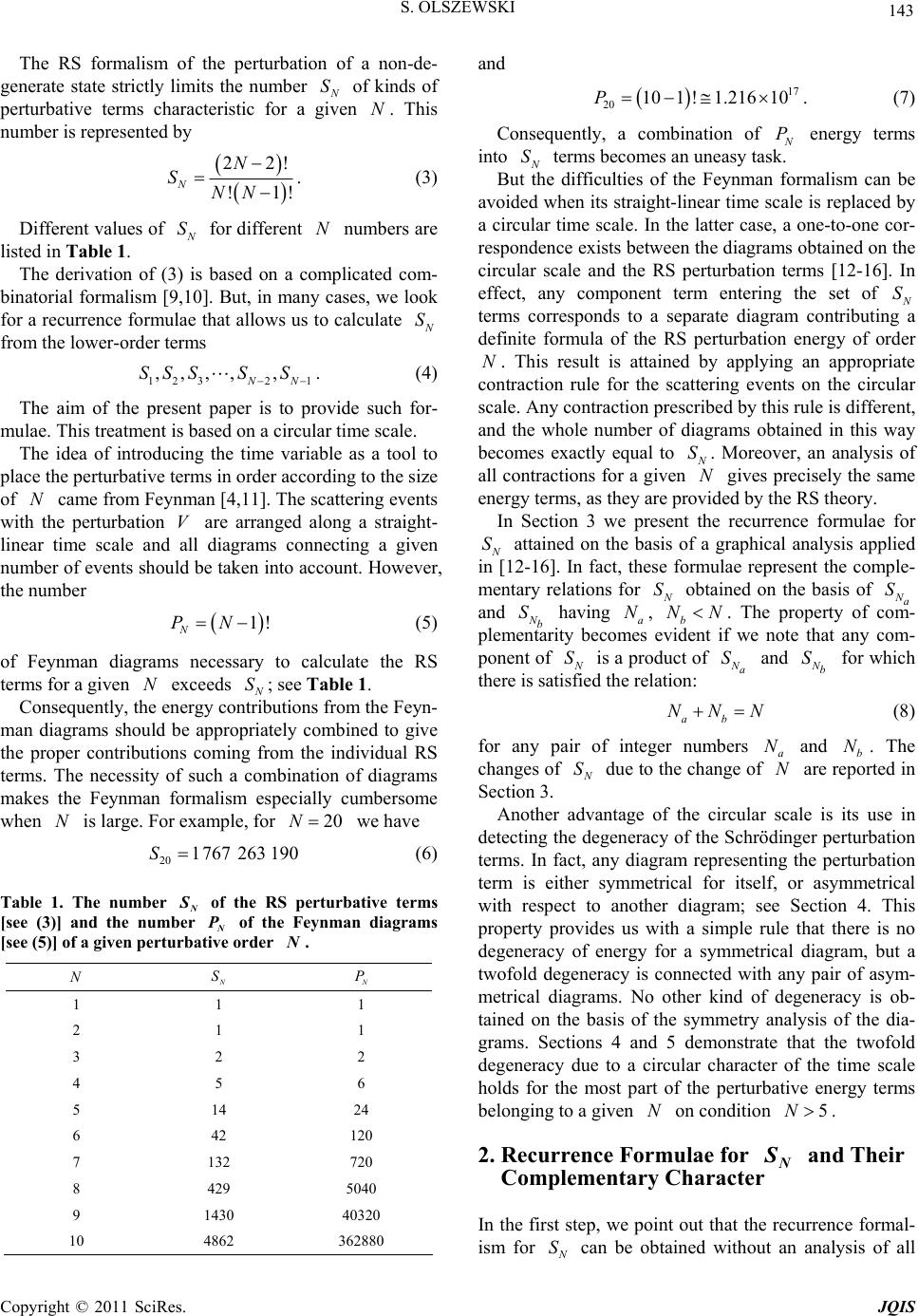 143 S. OLSZEWSKI The RS formalism of the perturbation of a non-de- generate state strictly limits the number S of kinds of perturbative terms characteristic for a given . This number is represented by N 22 !1 N N SNN ! ! . (3) Different values of S for different numbers are listed in Table 1. N The derivation of (3) is based on a complicated com- binatorial formalism [9,10]. But, in many cases, we look for a recurrence formulae that allows us to calculate S from the lower-order terms 1232 1 ,,,, , NN SSSS S . (4) The aim of the present paper is to provide such for- mulae. This treatment is based on a circular time scale. The idea of introducing the time variable as a tool to place the perturbative terms in order according to the size of came from Feynman [4,11]. The scattering events with the perturbation are arranged along a straight- linear time scale and all diagrams connecting a given number of events should be taken into account. However, the number NV 1! N PN (5) of Feynman diagrams necessary to calculate the RS terms for a given exceeds N S; see Table 1. Consequently, the energy contributions from the Feyn- man diagrams should be appropriately combined to give the proper contributions coming from the individual RS terms. The necessity of such a combination of diagrams makes the Feynman formalism especially cumbersome when is large. For example, for we have N20N 20 1 767 263 190S (6) Table 1. The number N of the RS perturbative terms [see (3)] and the number N of the Feynman diagrams [see (5)] of a given perturbative order . N N N S N P 1 1 1 2 1 1 3 2 2 4 5 6 5 14 24 6 42 120 7 132 720 8 429 5040 9 1430 40320 10 4862 362880 and 17 20 101 !1.21610P . (7) Consequently, a combination of P energy terms into S terms becomes an uneasy task. But the difficulties of the Feynman formalism can be avoided when its straight-linear time scale is replaced by a circular time scale. In the latter case, a one-to-one cor- respondence exists between the diagrams obtained on the circular scale and the RS perturbation terms [12-16]. In effect, any component term entering the set of S terms corresponds to a separate diagram contributing a definite formula of the RS perturbation energy of order . This result is attained by applying an appropriate contraction rule for the scattering events on the circular scale. Any contraction prescribed by this rule is different, and the whole number of diagrams obtained in this way becomes exactly equal to N SN. Moreover, an analysis of all contractions for a given gives precisely the same energy terms, as they are provided by the RS theory. In Section 3 we present the recurrence formulae for S attained on the basis of a graphical analysis applied in [12-16]. In fact, these formulae represent the comple- mentary relations for S obtained on the basis of a and S b having a, b. The property of com- plementarity becomes evident if we note that any com- ponent of SN NN S is a product of a S and b S for which there is satisfied the relation: ab NNN (8) for any pair of integer numbers and b. The changes of a N N S due to the change of are reported in Section 3. N Another advantage of the circular scale is its use in detecting the degeneracy of the Schrödinger perturbation terms. In fact, any diagram representing the perturbation term is either symmetrical for itself, or asymmetrical with respect to another diagram; see Section 4. This property provides us with a simple rule that there is no degeneracy of energy for a symmetrical diagram, but a twofold degeneracy is connected with any pair of asym- metrical diagrams. No other kind of degeneracy is ob- tained on the basis of the symmetry analysis of the dia- grams. Sections 4 and 5 demonstrate that the twofold degeneracy due to a circular character of the time scale holds for the most part of the perturbative energy terms belonging to a given on condition . N5N 2. Recurrence Formulae for N and Their Complementary Character In the first step, we point out that the recurrence formal- ism for S can be obtained without an analysis of all Copyright © 2011 SciRes. JQIS 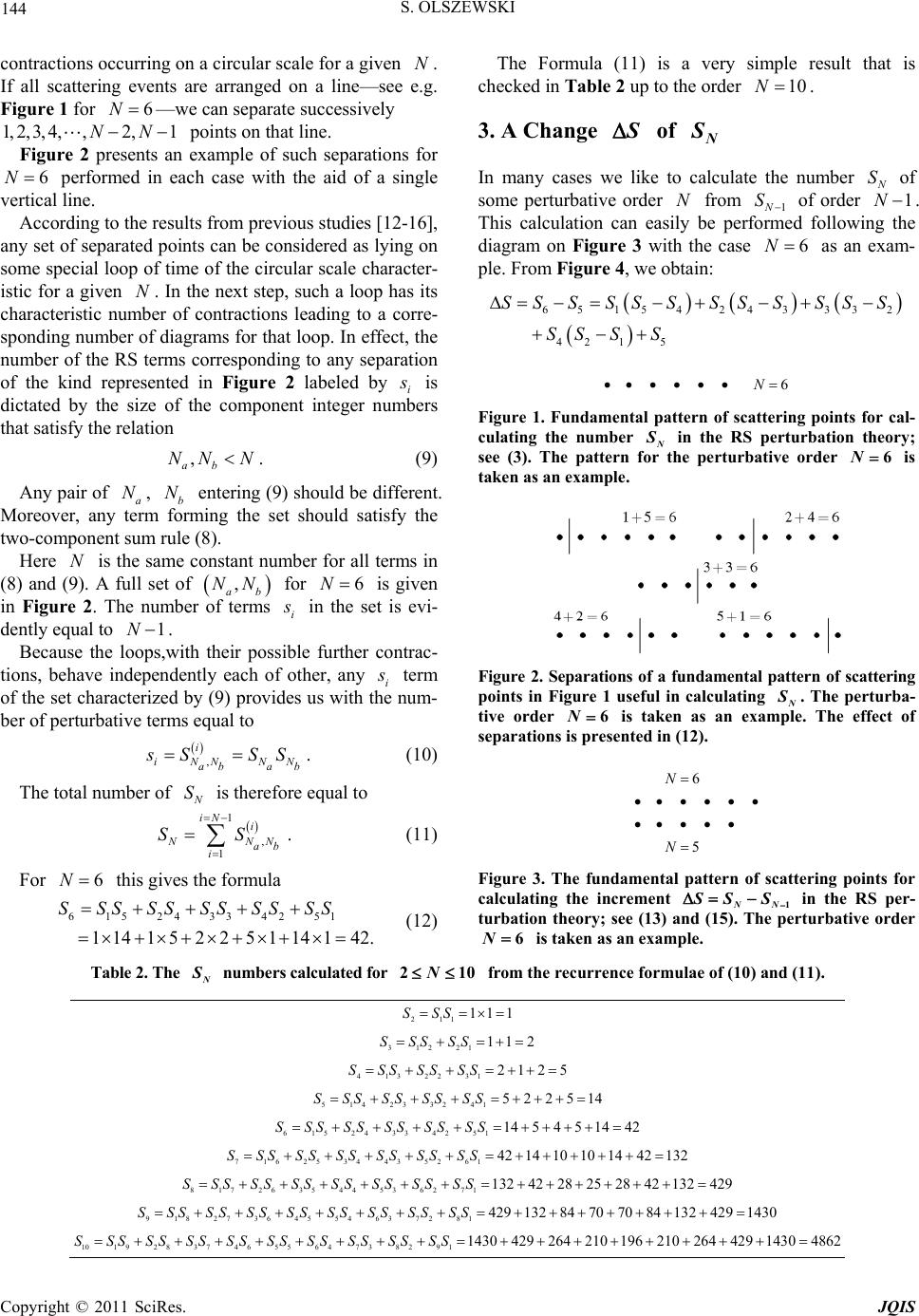 S. OLSZEWSKI Copyright © 2011 SciRes. JQIS 144 contractions occurring on a circular scale for a given . If all scattering events are arranged on a line—see e.g. Figure 1 for —we can separate successively points on that line. N 6N 2,N N 1,2,3, 4,,1N 6N The Formula (11) is a very simple result that is checked in Table 2 up to the order . 10N 3. A Change of N Figure 2 presents an example of such separations for performed in each case with the aid of a single vertical line. In many cases we like to calculate the number SN of some perturbative order from 1N of order NS 1 . This calculation can easily be performed following the diagram on Figure 3 with the case as an exam- ple. From Figure 4, we obtain: 6N According to the results from previous studies [12-16], any set of separated points can be considered as lying on some special loop of time of the circular scale character- istic for a given . In the next step, such a loop has its characteristic number of contractions leading to a corre- sponding number of diagrams for that loop. In effect, the number of the RS terms corresponding to any separation of the kind represented in Figure 2 labeled by i is dictated by the size of the component integer numbers that satisfy the relation 65 154243332 42 15 SSSSS SSSSSS S SS SS 6N Figure 1. Fundamental pattern of scattering points for cal- culating the number N in the RS perturbation theory; see (3). The pattern for the perturbative order 6N is taken as an example. , ab NN N. (9) Any pair of a, b entering (9) should be different. Moreover, any term forming the set should satisfy the two-component sum rule (8). N N N Here is the same constant number for all terms in (8) and (9). A full set of for is given in Figure 2. The number of terms , ab NN 6N i in the set is evi- dently equal to . 1N Because the loops,with their possible further contrac- tions, behave independently each of other, any i term of the set characterized by (9) provides us with the num- ber of perturbative terms equal to Figure 2. Separations of a fundamental pattern of scattering points in Figure 1 useful in calculating N . The perturba- tive order 6N is taken as an example. The effect of separations is presented in (12). , i i NN ab ab NN SSS . (10) 6 5 N N The total number of S is therefore equal to 1 , 1 iN i N N ab i SS . (11) Figure 3. The fundamental pattern of scattering points for calculating the increment 1NN SS in the RS per- turbation theory; see (13) and (15). The perturbative order 6N is taken as an example. For this gives the formula 6 15 14 1 SS N 6 2 15 S S 4334251 225 114142. SSSSSSS (12) Table 2. The N numbers calculated for 210N from the recurrence formulae of (10) and (11). 211 11 1SSS 31 SSS 221 11 2SS 41 231 212 5SSSSSS 32 S 5142 3241 522514SSSS SSS 3 SS 34 SS 35 S 36 S 7 SSS 82 S 615243 251 14 54 51442SSSSSS SSS 71625344 261 42 14 10 10 1442132SSSSSSSSS SSS 8172635445271 132 42 28 25 28 42132429SSSSSSSSSSS SSS 9 S 19 2 SSS 182736455463 281 429 13284707084 1324291430SSSSSSSSSSS SS 10837 46 55 6473911430 429 264 210196 210 264 42914304862SSSSSSSSSSSSS SS 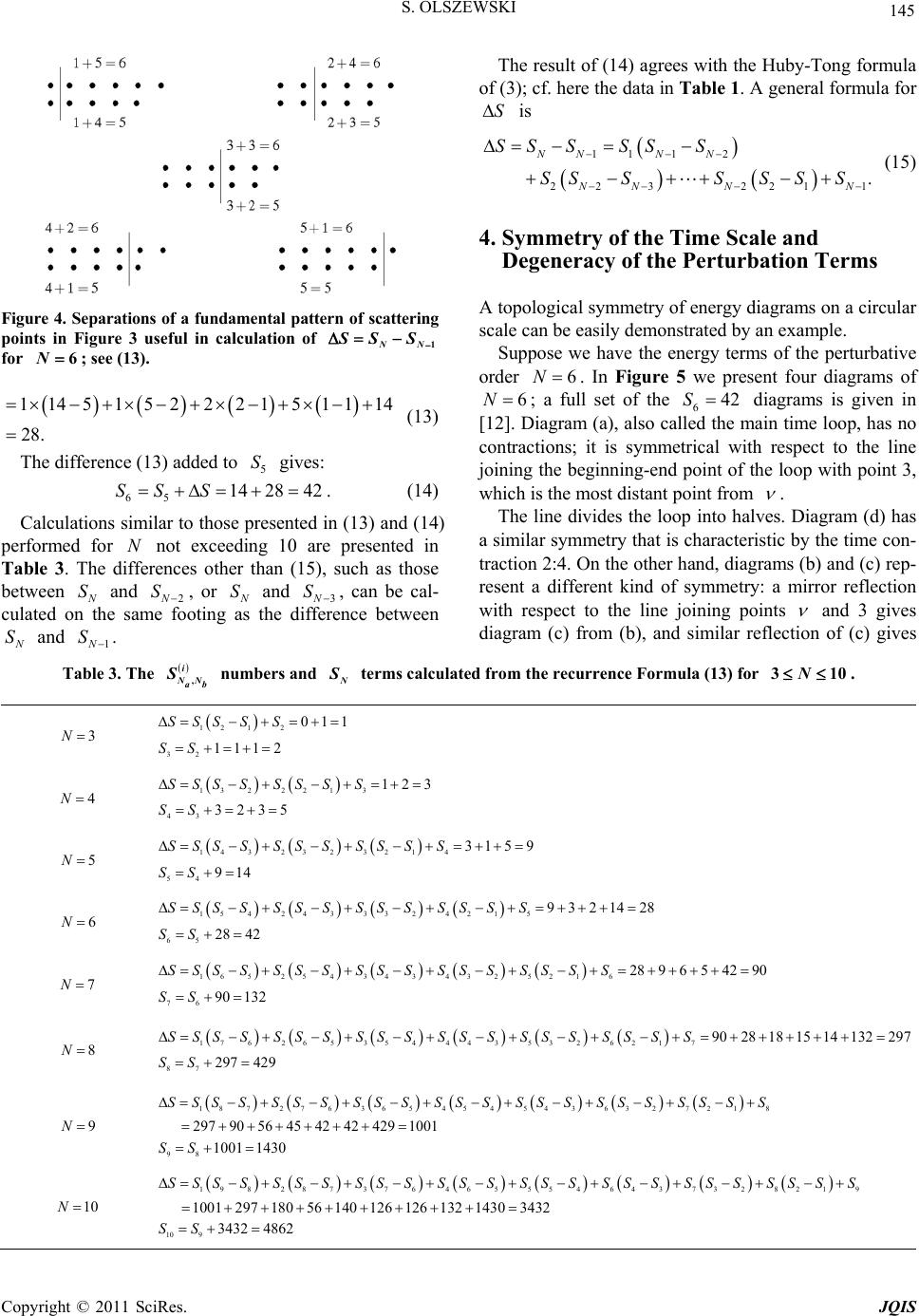 S. OLSZEWSKI 145 The result of (14) agrees with the Huby-Tong formula of Figure 4. Separations of a fundamental pattern of scattering points in Figure 3 useful in calculation of 1NN SS for 6N; see (13). 1145 1522 21 51114 28. (13) The difference (13) added to gives: (14) Calculations similar to those presented pe 5 S 65 14 2842SS S. in (13) and (14) rformed for N not exceeding 10 are presented in Table 3. The dirences other than (15), such as those between ffe S and 2N S, or S and 3N S, can be cal- culated onhe samoting the dince between te foasffere S and 1N S. (3); cf. here the data in Table 1. A general formula for S is 11 12 22 3221 . NN N NN NN SS SSSS SSSSS SS N 1 (15) . Symmetry of the Time Scale and rms ular 4Degeneracy of the Perturbation Te topological symmetry of energy diagrams on a circA scale can be easily demonstrated by an example. Suppose we have the energy terms of the perturbative order 6N . In Figure 5 we present four diagrams of 6N ; a ful D l set of the 642S diagrams is given in [1iagram (a), also calain time loop, has no contractions; it is symmetrical with respect to the line joining the beginning-end point of the loop with point 3, which is the most distant point from 2]. led the m . The line divides the loop into halves. Diagram (d) has a similar symmetry that is characteristic by the time con- traction 2:4. On the other hand, diagrams (b) and (c) rep- resent a different kind of symmetry: a mirror reflection with respect to the line joining points and 3 gives diagram (c) from (b), and similar reflection of (c) gives Ta3. ble The numbers and , i NN ab SN terms calculated from the recurrence Formula (13) for 310N. 3N 12 12011SSSSS 32 1112SS 4N 13222 13 12 3SSS SSS SS 43 3235SS 5 N 143 232 321 4315 9SSSSSSSSSS S 54 914SS 6 N 1542433324215 9321428S SSSSSSSSSSSSS 65 28 42SS 7 N 16 525 434 343 252 16289654290SSSSSS SSS SSSSSS SS 76 90 132SS 8N 17 626 535 444 353262 179028 18 1514 132297SSSSSS SSSSSS SSSSSS SS 87 297 429SS 9 N 18 727 636 545 454 363 27218 29790564542424291001 SSS SSS SSS SSS SSS SSS SSSSS 98 1001 1430SS 10 N 19 828 737646 555 464 373 28219 10012971805614012612613214303432 SSSSSSS SSS SSSSSS SSSSSS SSSS 1093432 4862SS Copyright © 2011 SciRes. JQIS 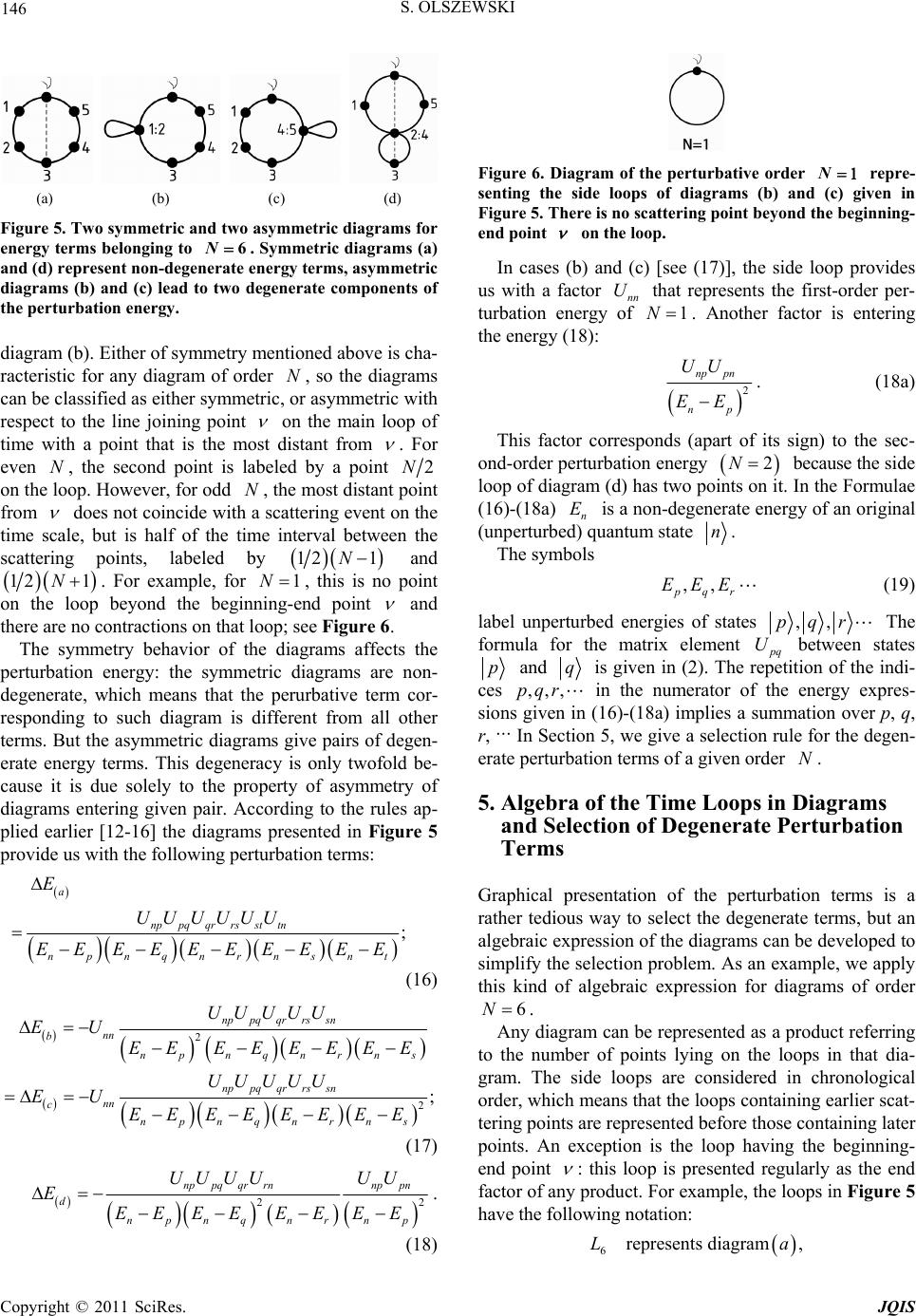 S. OLSZEWSKI 146 (a) (b) (c) (d) Figure 5. Two symmetric and two asymmetric diagrams for energy terms belonging to . Symmetric diagrams (a) and (d) represent non-deergy termymmetri diag of respect to the line joining point 6N generte enas, asc rams (b) and (c) lead to two degenerate components the perturbation energy. diagram (b). Either of symmetry mentioned above is cha- racteristic for any diagram of order N, so the diagrams can be classified as either symmetric, or asymmetric with on the main loop of time with a point that is the most distant from . For even N, the second point is labeleby a point d 2N on the loop. However, for odd N, the most distant point from does not coincide with acattering event on the time scale, but is half of the time interval between the scattering points, labeled by s 12 Nand 1 12 1N. For example, fo1N, this is no point on the loop beyond the beginning-end point r and there are no contractions on that loop; see Figure 6. The symmetry behavior of the dias the energy: the symmetriagrams are non- degenerate, which means that the perurbative ter cor- responding to such diagram is different from all o grams affect perturbation ic d m ther terms. But the asymmetric diagrams give pairs of degen- erate energy terms. This degeneracy is only twofold be- cause it is due solely to the property of asymmetry of diagrams entering given pair. According to the rules ap- plied earlier [12-16] the diagrams presented in Figure 5 provide us with the following perturbation terms: ; a nppq qr rsst tn npnqnrnsnt E UUUUUU EEEEEEEEEE (16) 2 2 ; nppq qr rs sn nn b np nqnrns nppq qr rs sn nn c npnqnrns UUUUU EU EEEEEEEE UUUUU EU EEEEEEEE (17) 22 nppq qr rnnppn d npnqnr np UUUU UU EEEEE EEEE . (18) Figure 6. Diagram of the perturbative order N ) give nd the be repre senting the side loops of diagrams (b) and (cn in Figure 5. There is no scatter ing point bey oginning- end point - on the loop. In cases (b) and (c) [see (17)], the side loop provides us with a factor that represents the first-order per- turbation energy nn U of 1N . Another factor is entering the energy (18): 2 np pn np UU EE . (18a) This factor corresponds (apart of its sign) to the sec- on non-d ntum state d-order perturbation energy 2N because the side loop of diagram (d) has two points on it. In the Formulae (16)-(18a) n E is a egenerate energy of an original (unperturbed) quan. The sym la bols ,, pqr EEE (19) bel unperturbed energies of states ,,pqr The formula for the matrix element q U between states p and q is given in (2). The repetition of the indi- ces ,,,pqr in the numerator of the energy expres- sions given in (16)-(18a) implies a summation over p, q, r, 5, we give a scti··· In Section ate perturbation elee for the degen- er terms of a given mpply on rul order N. 5. Algebra of the Time Loops in Diagrams and Selection of Degenerate Perturbation Terms Graphical presentation of the perturbation terms is a rather tedious way to select the degenerate terms, but an algebraic expression of the diagrams can be developed to implify the selection problem. As an exaple, we as this kind of algebraic expression for diagrams of order 6N . Any diagram can be represented as a product referring the numb er of points lying on the loops in that dia-to gram. The side loops are considered in chronological order, which means that the loops containing earlier scat- tering points are represented before those containing later points. An exception is the loop having the beginning- end point : this loop is presented regularly as the end factor of any product. For example, the loops in Figure 5 have the following notation: 6represents diagram,La Copyright © 2011 SciRes. JQIS 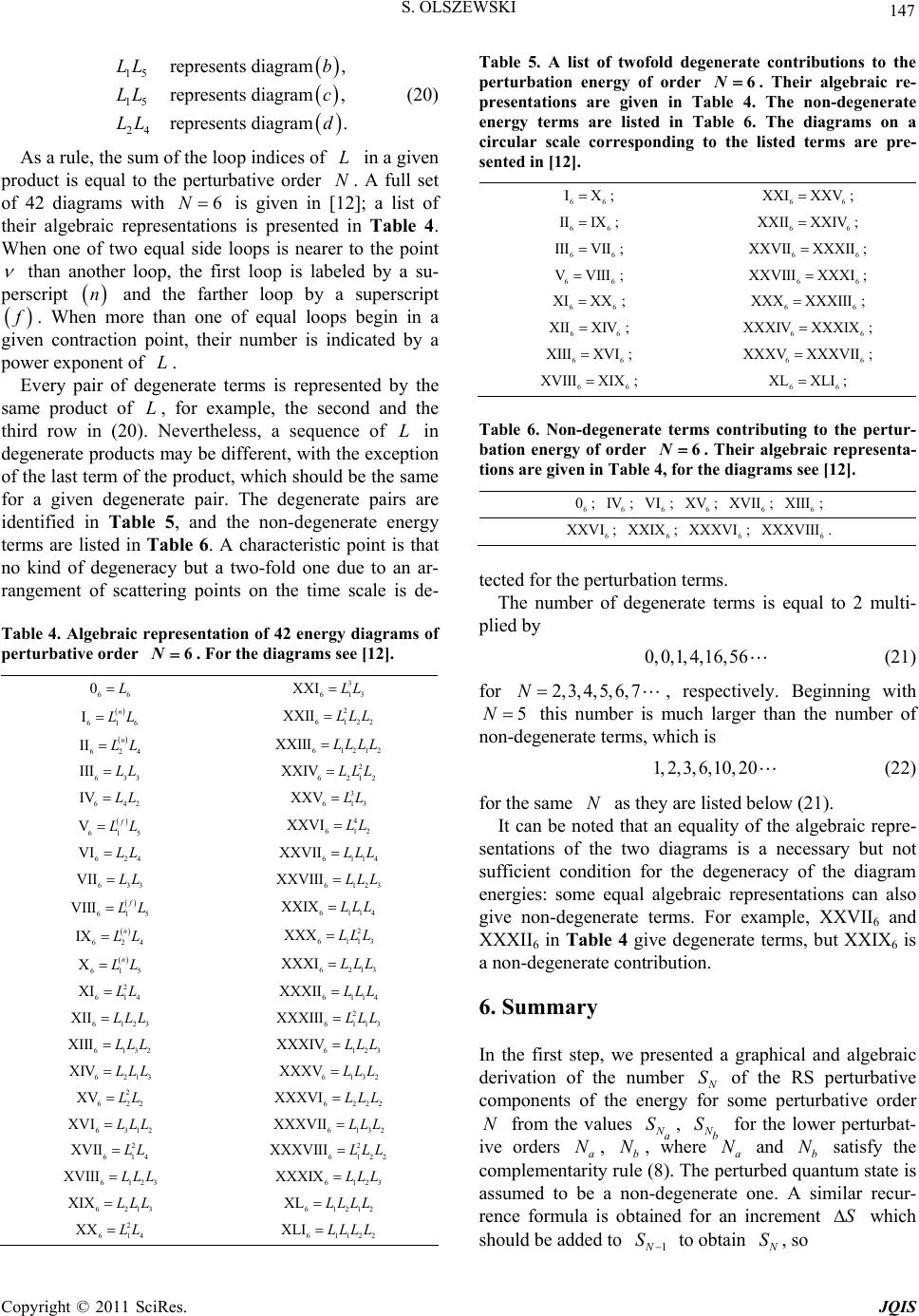 147 S. OLSZEWSKI Table 5. A list of twld degenerate contributions to the perturbation energy of order . Their algebe- presentations are gven in T The non-degenerate energy terms are listed in Table 6. The diagrams on a circular scale correonding to the listed terms are pre- sented in [12]. is given in [12]; a list of their algebraic represetions is presented in Table 4. When one of two eqloops is nearto the point 15 15 24 represents diagram, represents diagram, represents diagram. LL b LL c LL d (20) As a rule, the sum of the loop indices of L in a given product is equal to the perturbative order N. A full set of 42 diagrams with 6N nta ual side er than another loopt loop is labeled by a su- perscript andher loop by , the firs the fart n a superscript . Wheore than oe of equal login in a n cont por numbby a se or ex of n d iden ut a two-fold one due to an ar- ra n m raction n int, thei ops be er is indicated give power exponent of L. Every pair of degenerate terms is reprented by the same product of L, fample, the second and the third row in (20). Nevertheless, a sequence of L in degenerate products may be different, with the exception the last term of the product, which should be the same for a giveegenerate pair. The degenerate pairs are tified in Table 5, and the non-degenerate energy terms are listed in Table 6. A characteristic point is that no kind of degeneracy b ngement of scattering points on the time scale is de- Table 4. Algebraic representation of 42 energy diagrams of perturbative order 6N. For the diagrams see [12]. 66 0 3 613 XXI L 616 In L 2 6122 XXII LL 624 II n L 61212 XXIII LLL 633 III L 2 6212 XXIV LL 642 IV L 3 613 XXV L f 615 V L 61 2 XXVI 4 L 624 VI L 6114 XXVII LL 63 VII 3 L 612 XXVIII ofo 6N able 4.raic r i sp 66 IX; 66 XXI XXV; 66 II IX; ; ; 66 XXII XXIV; 66 III VII; 66 XXVII XXXII; 66 VVIII; 66 XXVIII XXXI; 66 XI XX; 66 XXX XXXIII; 66 XII XIV; 66 XXXIV XXXIX; 66 XIII XVI 66 XXXV XXXVII 66 XVIII X; IX 66 XL XLI; Table 6. Non-degerate terms contributing to the pertur- bation energy of oer 6N ne rd . Their algebraic repenta- tions are given in Table 4, for te diagrams see [12]. ; res h 6 0; 6 IV; 6 VI; 6 XV; 6 XVII; 6 XIII 6 XXVI ; 6 IX; XX 6 XXXVI ; 6 XXXVIII . tected for the perturbation terms. (21) for The number of degenerate terms is equal to 2 multi- plied by 0, 0,1,4,16, 56 2,3, 4, 6,N 3 LL 61 VIII f 5 L 611 XXIX 4 LL 62 IX n 4 L 2 611 XXX 3 LL 61 Xn 5 L 6 213 XXXI LL 2 61 XI 4 L 611 XXXII4 LL 612 XII 3 LL 2 611 XXXIII 3 LL 613 XIII 2 LL 612 XXXIV 3 LL 6 213 XIV LL 613 XXXV 2 LL 2 62 XV 2 L 622 XXXVI 2 LL 631 XVI 2 LL 613 XXXVII2 LL 2 61 XVII 4 L 2 612 XXXVIII 2 LL 612 XVIII 3 LL 612 XXXIX 3 LL 621 XIX 3 LL 6121 XL 2 LLL 2 61 XX 4 L 6112 XLI 2 LLL ,5 7 5 , ecy. Binnresptiveleging with N this numbr is meuch la numrger than theber of on-degenerate terms, which is e as they are listed below (21). It can be noted that an equality of t sentations of the two diagrams is a cient condition for energi example, XXVII6 and XXXII6 in Table 4 give degenerate te a non-degenerate contribution. 6. n 1,2,3,6,10, 20 (22) for the samN he algebraic repre- necessary but not suffi the degeneracy of the diagram es: some equal algebraic representations can also give non-degenerate terms. For rms, but XXIX6 is Summary In the first step, we presented a graphical and algebraic derivation of the number S of the RS perturbative components of the energy for some perturbative order N from the values a S, b S for the lower perturbat- ive orders a N, b N, where a rt n i N The e and satisfy the urbetum state is ate one. A ilar recur- ce formula is obtaincrem b N d quan sim ent complementarity r assumed to be a u no le (8). n-deg ned e p ner for arenS which should be added to 1N S to obtain S, so Copyright © 2011 SciRes. JQIS 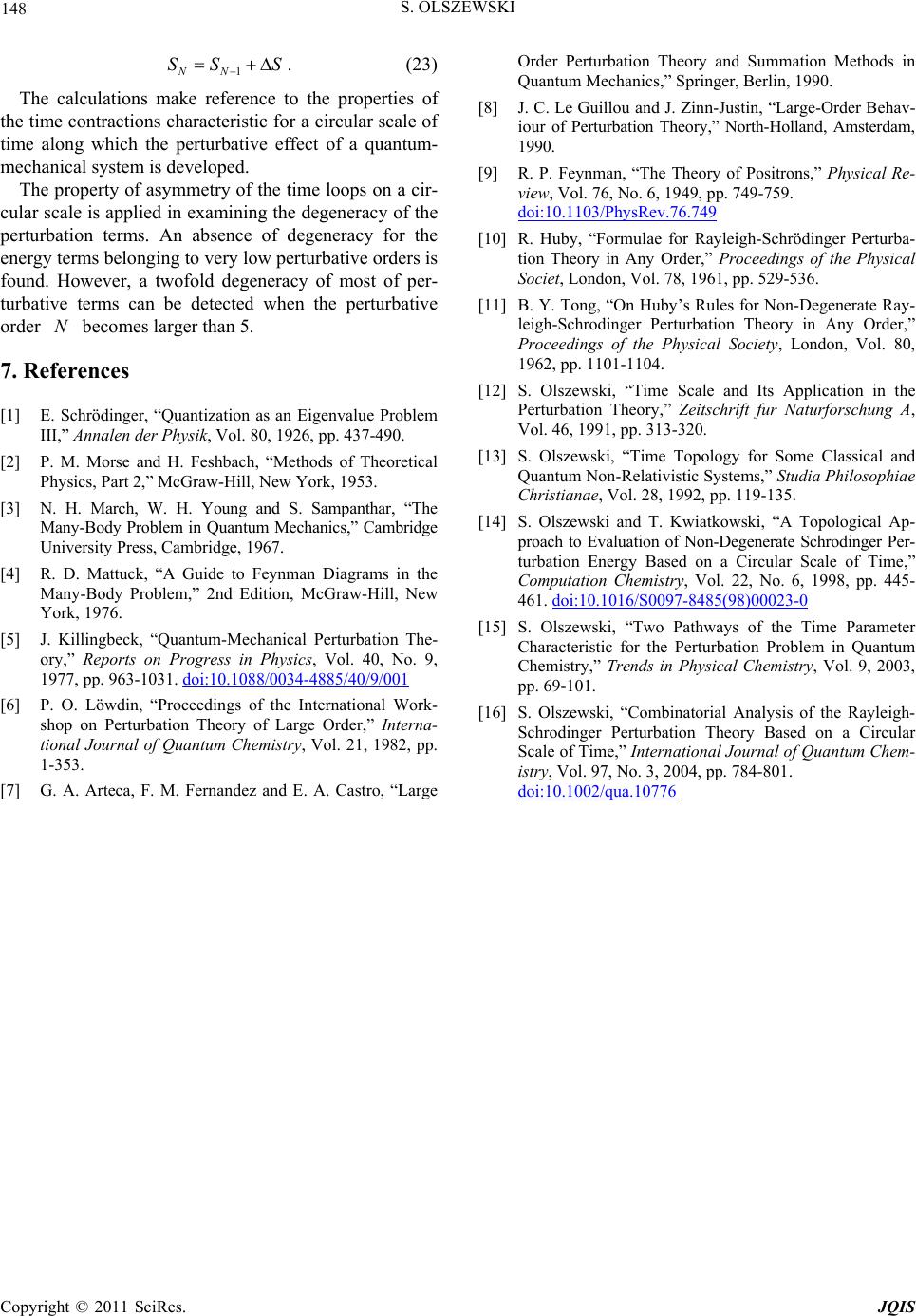 S. OLSZEWSKI Copyright © 2011 SciRes. JQIS 148 deacy for the energy terms belonging to very low p fo an Mechanics,” Cambridge ss, Cambridge, 1967. , “A Guide to Feynman Diagrams in the 1NN SS S . (23) The calculations make reference to the properties of the time contractions characteristic for a circular scale of time along which the perturbative effect of a quantum- mechanical system is developed. The property of asymmetry of the time loops on a cir- cular scale is applied in examining the degeneracy of the perturbation terms. An absence of gener erturbative orders is und. However, a twofold degeneracy of most of per- turbative terms can be detected when the perturbative order N becomes larger than 5. 7. References [1] E. Schrödinger, “Quantization as an Eigenvalue Problem III,” Annalen der Physik, Vol. 80, 1926, pp. 437-490. [2] P. M. Morse and H. Feshbach, “Methods of Theoretical Physics, Part 2,” McGraw-Hill, New York, 1953. [3] N. H. March, W. H. Young and S. Sampanthar, “The My-Body Problem in Quantum University Pre 4] R. D. Mattuck[ Many-Body Problem,” 2nd Edition, McGraw-Hill, New York, 1976. J. Killingbeck, “Quantum-Mechanical Perturbation T[5] he- ory,” Reports on Progress in Physics, Vol. 40, No. 9, 1977, pp. 963-1031. doi:10.1088/0034-4885/40/9/001 y, Vol. 21, 1982, pp. Guillou and J. Zinn-Justin, “Large-Order Behav- ysical Re- Order Perturbation Theory and Summation Methods in Quantum Mechanics,” Springer, Berlin, 1990. [8] J. C. Le iour of Perturbation Theory,” North-Holland, Amsterdam, 1990. [9] R. P. Feynman, “The Theory of Positrons,” Ph view, Vol. 76, No. 6, 1949, pp. 749-759. doi:10.1103/PhysRev.76.749 [10] R. Huby, “Formulae for Rayleigh-Schrödinger Perturba- 6. s for Non-Degenerate Ray- Topology for Some Classical and owski, “A Topological Ap- 1998, pp. 445- tion Theory in Any Order,” Proceedings of the Physical Societ, London, Vol. 78, 1961, pp. 529-53 [11] B. Y. Tong, “On Huby’s Rule leigh-Schrodinger Perturbation Theory in Any Order,” Proceedings of the Physical Society, London, Vol. 80, 1962, pp. 1101-1104. [12] S. Olszewski, “Time Scale and Its Application in the Perturbation Theory,” Zeitschrift fur Naturforschung A, Vol. 46, 1991, pp. 313-320. [13] S. Olszewski, “Time Quantum Non-Relativistic Systems,” Studia Philosophiae Christianae, Vol. 28, 1992, pp. 119-135. [14] S. Olszewski and T. Kwiatk proach to Evaluation of Non-Degenerate Schrodinger Per- turbation Energy Based on a Circular Scale of Time,” Computation Chemistry, Vol. 22, No. 6, 461. doi:10.1016/S0097-8485(98)00023-0 [15] S. Olszewski, “Two Pathways of the Time Parameter Characteristic for the Perturbation Problem in Quantum Chemistry,” Trends in Physical Chemistry, Vol. 9, 2003, pp. 69-101. [6] P. O. Löwdin, “Proceedings of the International Work- shop on Perturbation Theory of Large Order,” Interna- tional Journal of Quantum Chemistr [16] S. Olszewski, “Combinatorial Analysis of the Rayleigh- Schrodinger Perturbation Theory Based on a Circular Scale of Time,” International Journal of Quantum Chem- istry, Vol. 97 1-353. [7] G. A. Arteca, F. M. Fernandez and E. A. Castro, “Large , No. 3, 2004, pp. 784-801. doi:10.1002/qua.10776
|